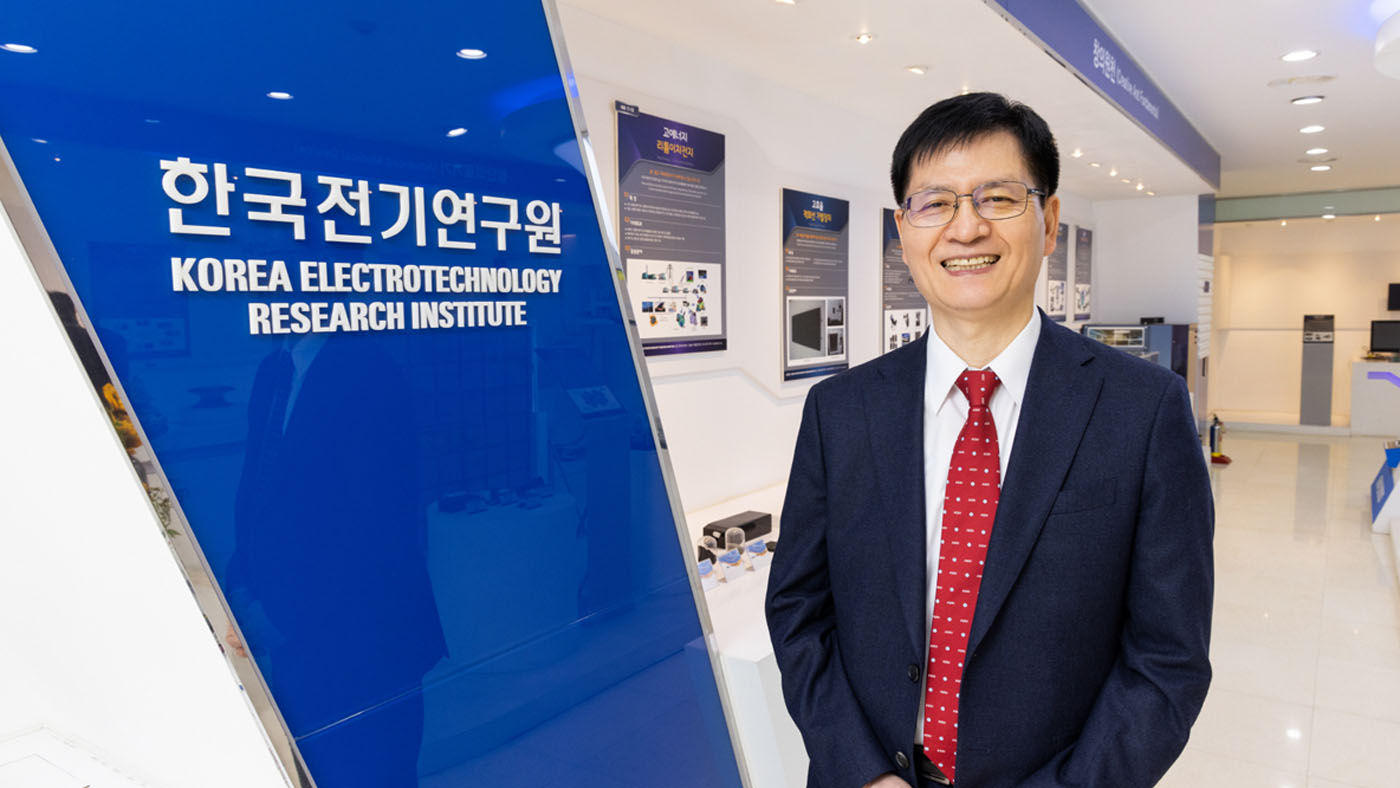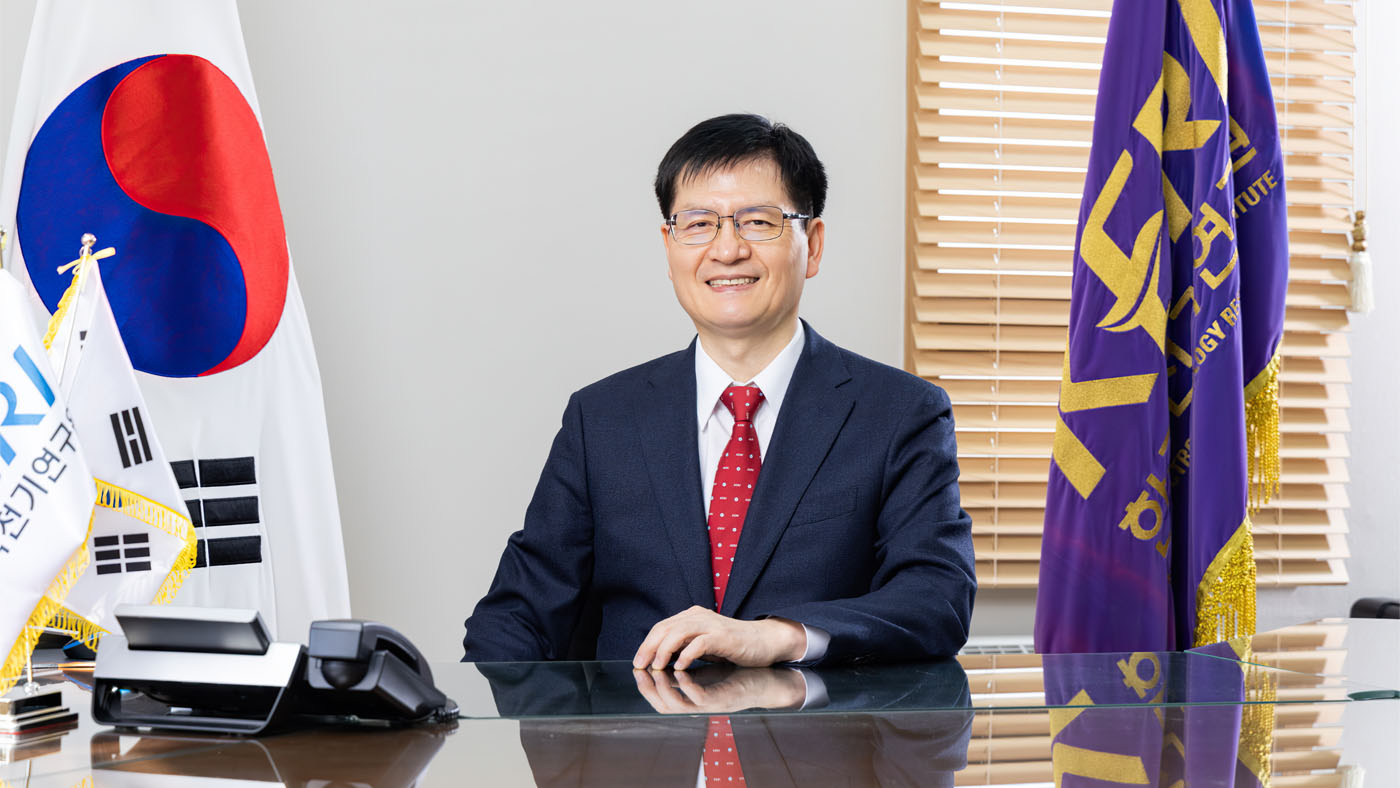บทความ
24/04/2567
Electrified World Alliance ไทย-เกาหลีใต้ ร่วมพัฒนาห้องปฏิบัติการทดสอบอุปกรณ์ไฟฟ้าแรงสูง
ความสำคัญในการพัฒนาระบบการทดสอบอุปกรณ์ไฟฟ้าแรงสูงเป็นสิ่งที่มีความจำเป็นอย่างมากในโลกปัจจุบัน มาทำความรู้จักกับผู้นำด้านเทคโนโลยีไฟฟ้าและความร่วมมือกับประเทศไทยผ่านบทสัมภาษณ์ของ Dr. Kim Nam-Kyun ประธานสถาบันวิจัย Korea Electrotechnology Research Institute (KERI)
ปัจจุบันเกาหลีใต้ ถือเป็นหนึ่งในประเทศแถวหน้าของการพัฒนาในภูมิภาคเอเชียตะวันออกและที่น่าจับตามองคือการพัฒนาด้านการทดสอบอุปกรณ์ไฟฟ้าแรงสูง ซึ่งมี Korea Electrotechnology Research Institute (KERI) สถาบันวิจัยที่ถือเป็นฟันเฟืองสำคัญในการขับเคลื่อนประเด็นนี้ โดยเมื่อวันที่ 26 กุมภาพันธ์ที่ผ่านมา กฟผ. ได้ร่วมมือกับทางสถาบันวิจัย KERI ผ่านการลงนามในบันทึกข้อตกลงความร่วมมือ เพื่อเพิ่มศักยภาพและขีดความสามารถของห้องปฏิบัติการทดสอบอุปกรณ์ไฟฟ้าแรงสูง (High Voltage Laboratory) สู่มาตรฐานสากล โดยในบทความนี้เราได้โอกาสพิเศษในการพูดคุยกับ Dr. Kim Nam-Kyun ประธานสถาบันวิจัย Korea Electrotechnology Research Institute (KERI) ที่จะมาบอกเล่าเกี่ยวกับเป้าหมายของการร่วมมือในครั้งนี้ รวมไปถึงการเปิดมุมมองต่อทิศทางของเทคโนโลยีไฟฟ้าแรงสูงในอนาคต
ทำความรู้จักกับสถาบันวิจัย Korea Electrotechnology Research Institute (KERI)
“Korea Electrotechnology Research Institute (KERI) ถือเป็นสถาบันวิจัยที่ได้รับการสนับสนุนจากรัฐบาล อยู่ภายใต้สังกัดกระทรวงวิทยาศาสตร์และเทคโนโลยีสารสนเทศของประเทศเกาหลีใต้ ภารกิจหลักของสถาบันฯ นับตั้งแต่การก่อตั้งในปี ค.ศ. 1976 คือ การพัฒนาอุตสาหกรรมพลังงานและอุปกรณ์ไฟฟ้าของเกาหลีใต้ ผ่านการให้บริการด้านการวิจัยและพัฒนา รวมไปถึง
การทดสอบและการรับรองความปลอดภัย โดยทางสถาบันฯ มีความเชี่ยวชาญในการวิจัยและพัฒนา ครอบคลุมตั้งแต่การสร้างระบบโครงสร้างพื้นฐาน ไปจนถึงการพัฒนาเทคโนโลยีล้ำสมัย ทั้งในแง่ของระบบโครงข่ายไฟฟ้า (Power Grid) และแหล่งพลังงานทดแทน ระบบสายส่งกระแสตรง แรงดันสูงและอุปกรณ์ไฟฟ้า เทคโนโลยีเซมิคอนดักเตอร์และซูเปอร์คอนดักเตอร์ รวมไปถึงการนำเทคโนโลยีทางไฟฟ้ามาประยุกต์ เช่น การควบคุมมอเตอร์ไฟฟ้าด้วยหุ่นยนต์ เทคโนโลยีขับเคลื่อนยานอวกาศด้วยไฟฟ้า เทคโนโลยีวัสดุนาโนและแบตเตอรี่ และอุปกรณ์การแพทย์ที่ใช้พลังงานไฟฟ้า
ทั้งนี้ สถาบันวิจัย KERI ยังเป็นหนึ่งในสมาชิกของ Short-Circuit Testing Liaison (STL) ซึ่งเป็นหน่วยงานที่ได้รับการยอมรับในระดับสากลในเรื่องของการทดสอบและให้การรับรองสำหรับอุปกรณ์ไฟฟ้า ในฐานะที่เราเป็นศูนย์ปฏิบัติการทดสอบขนาดใหญ่เป็นอันดับสองของโลก เรามีเครื่องมือและอุปกรณ์อันทันสมัย รวมไปถึงบุคลากรที่มีทักษะสูง เราใช้ความเชี่ยวชาญของเราในการส่งเสริมบริษัทอุปกรณ์ไฟฟ้าในประเทศ ให้สามารถแข่งขันในระดับโลกได้อย่างมีประสิทธิภาพ ซึ่งเราต้องทำให้มั่นใจว่า รายงานการทดสอบของ KERI ได้รับการยอมรับอย่างกว้างขวางในเวทีโลก”
ที่มาและเป้าหมายของบันทึกข้อตกลงความร่วมมือ (MOU) ฉบับนี้คืออะไร
“กฟผ. เป็นหน่วยงานรัฐวิสาหกิจของประเทศไทย ซึ่งเป็นตลาดด้านอุปกรณ์พลังงานไฟฟ้าที่ใหญ่ที่สุดในอาเซียน อย่างไรก็ตาม ประเทศไทยกำลังอยู่ในช่วงปรับปรุงและขยายโครงสร้างพื้นฐานในด้านการทดสอบอุปกรณ์ไฟฟ้าเพื่อให้สอดรับกับความต้องการอุปกรณ์การทดสอบใหม่ ๆ ที่เพิ่มสูงขึ้นอย่างมาก และต้องแข่งขันกับประเทศเวียดนามและอินโดนีเซียที่กำลังเติบโต ในฐานะที่ KERI เป็นสถาบันชั้นนำของโลกในด้านการทดสอบอุปกรณ์ไฟฟ้าและการออกหนังสือรับรอง เรามีเครื่องมือที่ยอดเยี่ยมและทีมงานที่เชี่ยวชาญ เราวางเป้าหมายร่วมกับประเทศไทยในการปรับปรุงหรือก่อสร้างห้องปฏิบัติการทดสอบอุปกรณ์ไฟฟ้าแรงสูง ซึ่งเรามีประสบการณ์มากมาย อาทิ การทำสัญญามูลค่า 1 พันล้านวอน (27 ล้านบาท) ในการช่วยก่อสร้างห้องปฏิบัติการของบริษัทยักษ์ใหญ่อย่าง Aramco จากซาอุดีอาระเบีย ประสบการณ์ของเราสามารถสร้างความมั่นใจได้ว่า เรามีศักยภาพเพียงพอที่จะส่งมอบงานที่ยอดเยี่ยมให้กับประเทศไทย โดยเป้าหมายสูงสุดของเราคือการสร้างให้ KERI เป็นแบรนด์ที่ได้รับความเชื่อถือสูงสุดในอุตสาหกรรมพลังงานของไทย
กฟผ. มีความจำเป็นอย่างยิ่งที่ต้องมีอุปกรณ์ไฟฟ้าที่มีเสถียรภาพ เพื่อบรรลุภารกิจในการดูแลพลังงานไฟฟ้าให้กับประเทศไทย ซึ่งเราทราบถึงความต้องการของ กฟผ. ที่ต้องมีเครื่องมือทดสอบอุปกรณ์ไฟฟ้าแรงดันสูงและกำลังไฟฟ้าแรงสูง สิ่งสำคัญที่ต้องมีสำหรับการสร้างห้องปฏิบัติการ ทดสอบนี้คือการฝึกอบรมทางเทคนิคในด้านวิศวกรรมก่อสร้างของอุปกรณ์การทดสอบและการดำเนินการ โดยทาง KERI ที่มีประสบการณ์ในการดำเนินการห้องทดสอบมากว่า 45 ปี เราจึงพร้อมที่จะช่วย กฟผ. ให้ได้รับความเชี่ยวชาญทางเทคโนโลยีในด้านการทดสอบไฟฟ้าแรงดันสูงและกำลังไฟฟ้าแรงสูง รวมไปถึงวิศวกรรมการก่อสร้างห้องปฏิบัติการทดสอบ และการพัฒนาอุปกรณ์ไฟฟ้า
ทั้งหมดที่กล่าวมานี้ แสดงให้เห็นว่า KERI คือพันธมิตรที่เหมาะสมของ กฟผ. ในด้านการฝึกอบรมทางเทคนิคและวิศวกรรม และเราหวังว่าข้อตกลง MOU ฉบับนี้ จะเป็นจุดเริ่มต้นในการสร้างความร่วมมือในอนาคต”
อะไรคือความท้าทายและอุปสรรคในการทำงานร่วมกัน
“กฟผ. ถือเป็นหน่วยงานที่ดูแลด้านพลังงานไฟฟ้าขนาดใหญ่ของประเทศไทย เปรียบเทียบได้กับ Korea Electric Power Corporation (KEPCO) ของเกาหลีใต้ ในขณะที่สถาบันวิจัย KERI เป็นผู้เชี่ยวชาญในการวิจัยและพัฒนา การทดสอบ และการออกใบรับรอง แน่นอนว่าเราทั้งสองมีความแตกต่างกันทั้งทางด้านขนาดขององค์กร บทบาท ภูมิประเทศ และสัญชาติ ซึ่งก็อาจทำให้เกิดอุปสรรคในด้านการประสานงานอยู่บ้าง แต่เราเชื่อมั่นว่า สิ่งที่เรายึดถือร่วมกันคือความมุ่งมั่นในการพัฒนานวัตกรรม และความต้องการเอาชนะอุปสรรคต่าง ๆ จะทำให้ความร่วมมือในการทำงานประสบความสำเร็จได้”
ช่วยเล่าให้ฟังถึงหน่วยทดสอบกำลังไฟฟ้าแรงสูง 8000 MVA และระบบ HVDC
“หน่วยทดสอบกำลังไฟฟ้าแรงสูงก็เหมือนกับโครงข่ายไฟฟ้าย่อส่วนมาอยู่ในสภาพแวดล้อมของห้องปฏิบัติการ ห้องนี้จะทำหน้าที่ในการทดสอบการทำงานของอุปกรณ์ไฟฟ้าที่ถูกใช้ในโครงข่ายไฟฟ้า ตั้งแต่โรงงานไฟฟ้าไปจนถึงปลั๊กไฟภายในบ้าน หน่วยทดสอบนี้มีเครื่องมือทางเทคนิคที่ทำหน้าที่จำลองระบบไฟฟ้าในระบบใช้งานจริง เช่น เครื่องกำเนิดไฟฟ้าแบบลัดวงจร (Short-Circuit Generator) ซึ่งทำหน้าที่เหมือนโรงไฟฟ้า หม้อแปลงไฟฟ้าแบบลัดวงจร (Short-Circuit Transformer) ทำหน้าที่เหมือนสถานีไฟฟ้าย่อย รางทดสอบและสายส่ง (Testing Busbars and Cables) ทำหน้าที่เหมือนสายส่ง และอุปกรณ์ไฟฟ้า (Load Devices) จำลองความต้องการใช้ไฟของลูกค้า นอกจากนี้ ยังมีชุดอุปกรณ์ที่ครอบคลุมสำหรับการทดสอบ การป้องกัน การควบคุม การวัด และการตรวจสอบอีกด้วย
ในปี ค.ศ. 1978 KERI ได้สร้างสถานีทดสอบพร้อมเครื่องกำเนิดไฟฟ้าแบบลัดวงจร เพื่อให้บริการการทดสอบไฟฟ้าแรงสูงและเปิดใช้งานอย่างเป็นทางการในอีก 4 ปีถัดมา นอกจากนี้ เรายังได้ดำเนินการพัฒนาห้องปฏิบัติการอย่างต่อเนื่อง เพื่อตอบสนองต่อปริมาณความต้องการไฟฟ้าที่เพิ่มขึ้นของโลก โดยเฉพาะในระหว่างปี ค.ศ. 2011 - 2016 KERI ได้ลงทุนราว 1.6 แสนล้านวอน (4.3 พันล้านบาท) เพื่อติดตั้งความจุไฟฟ้าเพิ่มเติมจำนวน 4000 MVA ส่งผลให้ในปัจจุบันสถานีปฏิบัติการของเรามีความจุไฟฟ้ารวมทั้งหมดสูงถึง 8000 MVA (เทียบเท่ากับโรงไฟฟ้านิวเคลียร์จำนวน 8 แห่ง) ความพร้อมนี้ทำให้เราสามารถทดสอบอุปกรณ์ไฟฟ้าที่ใช้ในโครงข่ายไฟฟ้าแรงสูงที่สุดในโลกได้ ส่งผลให้เรากลายเป็นผู้นำระดับโลกในด้านประสิทธิภาพและคุณภาพในการทดสอบไฟฟ้าแรงสูง
เมื่อไม่นานมานี้ โครงข่ายพลังงานโลกกำลังเปลี่ยนผ่านจากระบบการจ่ายไฟฟ้าด้วยระบบสายส่งกระแสสลับแรงดันสูง (HVAC) มาเป็นระบบสายส่งกระแสตรงแรงดันสูง (HVDC) ซึ่งทำให้เกิดการเริ่มต้นการพัฒนาเทคโนโลยีไฟฟ้าและสินค้าในระบบ HVDC อย่างกว้างขวาง โดยทาง KERI ได้ร่วมลงทุนกับรัฐบาลส่วนกลางและส่วนภูมิภาคของเกาหลีใต้ราว 2 หมื่นล้านวอน (504 ล้านบาท) เพื่อดำเนินการสร้างโครงสร้างพื้นฐานในการทดสอบไฟฟ้าในระบบ HVDC ตั้งแต่ปี ค.ศ. 2020 จนถึงสิ้นสุดปี ค.ศ. 2023 ซึ่งระบบดังกล่าวจะถูกใช้สำหรับการพัฒนาผลิตภัณฑ์ การทดสอบ และการรับรองอุปกรณ์ต่าง ๆ ที่เกี่ยวกับ HVDC อาทิ อุปกรณ์แปลงสัญญาณ เบรกเกอร์ หรือสายเคเบิ้ล เป็นต้น”
ปัจจุบัน KERI กำลังให้ความสนใจในการศึกษาวิจัยในประเด็นใด
“ระบบการจัดการพลังงานอัจฉริยะ (EMS) และอุปกรณ์พลังงานที่เป็นมิตรต่อสิ่งแวดล้อม คือประเด็นที่ทางสถาบัน KERI สนใจในขณะนี้ การนำระบบจัดการพลังงานอัจฉริยะ (EMS) มาใช้ก็เปรียบเสมือนการปฏิวัติด้านเทคโนโลยีพลังงานเลยทีเดียว โดย EMS เปรียบดั่ง ‘สมอง’ ของโครงข่าย ซึ่งสามารถตรวจสอบดูแลการทำงานได้ตลอดเวลา ไม่ว่าจะเป็นในโรงไฟฟ้า สถานีย่อย ไปจนถึงระบบส่ง ทั้งนี้ โครงข่ายไฟฟ้ามักถูกเปรียบให้เหมือนกับเส้นเลือดที่หล่อเลี้ยงร่างกายของมนุษย์ หากเกิดปัญหาขึ้นที่ส่วนใดส่วนหนึ่ง ก็อาจส่งผลกระทบต่อร่างกายในภาพรวมได้หากไม่ได้รับการรักษาอย่างทันท่วงที แต่ด้วยระบบ EMS เราจะสามารถตรวจสอบภาพรวมของโครงข่ายไฟฟ้าทั้งหมด เพื่อให้เราแก้ไขปัญหาได้อย่างรวดเร็ว
โดยในปี ค.ศ. 2014 KERI ได้ร่วมกับองค์กร Korea Power Exchange (KPX) เพื่อพัฒนาระบบ EMS รุ่นที่ห้าของโลก ซึ่งมีส่วนสำคัญในการป้องกันการขัดข้องของระบบพลังงาน และในขณะที่ KERI กำลังเฉลิมฉลองการครบรอบ 10 ปีของเทคโนโลยีนี้ในปีนี้ เราก็กำลังพัฒนาไปอย่างต่อเนื่องโดยจะใช้ชื่อว่า ‘Smart EMS’
Smart EMS ถูกพัฒนาขึ้นด้วยความสามารถของระบบปัญญาประดิษฐ์ (AI) และเทคโนโลยีสารสนเทศ (ICT) โดยเสริมความสามารถของ ‘สมอง’ เพื่อดำเนินการและจัดการแหล่งพลังงานทดแทนที่ยากต่อการควบคุมและมีความผันผวนสูง นับเป็นเทคโนโลยีใหม่ล่าสุดที่จะสอดรับกับวิสัยทัศน์ความเป็นกลางทางคาร์บอนได้
สำหรับอีกหนึ่งประเด็นที่สนใจก็คือ อุปกรณ์พลังงานที่เป็นมิตรต่อสิ่งแวดล้อม ซึ่งจะช่วยลดแก๊สซัลเฟอร์เฮกซาฟลูออไรด์ (SF6) ที่ส่งผลกระทบทำให้เกิดสภาวะโลกร้อน ทั้งนี้ SF6 เป็นส่วนประกอบสำคัญในการผลิตฉนวนในอุปกรณ์ไฟฟ้า แต่ในขณะเดียวกัน ตามการวิจัยขององค์กร Korea Electric Power Corporation (KEPCO) มันเป็นแก๊สเรือนกระจกที่มีส่วนทำให้โลกร้อนและสร้างผลกระทบรุนแรงกว่าคาร์บอนไดออกไซด์กว่า 23,500 เท่า และเมื่อมันถูกปล่อยสู่ชั้นบรรยากาศ ก็จะคงอยู่ได้ถึง 3,200 ปี ก่อนจะย่อยสลายไปทั่วโลกกำลังมองหาทางเลือกอื่นที่เหมาะสมกว่า แต่ก็ยังไม่สามารถทำได้ มันเปรียบเสมือนกับการคิดค้นยารักษาโลกชนิดใหม่ให้กับโลกใบนี้เลยทีเดียว อย่างไรก็ตาม KERI คือหน่วยงานที่ค้นพบทางออกในเรื่องนี้ วัสดุที่นำมาทดแทนจะไม่มีสารพิษและไม่ส่งผลกระทบมากต่อสถานการณ์โลกร้อน เมื่อเรานำเทคโนโลยีใหม่นี้มาใช้ร่วมกับอุปกรณ์ไฟฟ้า และทำการทดสอบภายใต้กำลังไฟฟ้าแรงสูงในระดับหลายแสนโวลต์และหลายหมื่นแอมป์ ซึ่งก็พบว่าประสบความสำเร็จเป็นอย่างดี นวัตกรรมใหม่ของเราได้รับความสนใจอย่างมากจากองค์กรระหว่างประเทศและบริษัทต่างชาติต่าง ๆ ซึ่งทำให้เรามีโอกาสสร้างความร่วมมือในระดับโลกต่อไป”
ความร่วมมือระหว่าง กฟผ. และสถาบันวิจัย KERI ในครั้งนี้ ถือเป็นหมุดหมายสำคัญในการพัฒนาเทคโนโลยีการทดสอบอุปกรณ์ไฟฟ้าแรงสูงร่วมกัน ด้วยความเชื่อมั่นในองค์ความรู้และความเป็นสากลของสถาบัน KERI ของเกาหลีใต้และการเปิดรับนวัตกรรมและความร่วมมือของ กฟผ. การเดินทางของการพัฒนาพลังงานไฟฟ้าของประเทศไทยเพื่ออนาคตที่ดีและทันสมัยได้เริ่มต้นขึ้นอย่างเป็นทางการแล้ว
The importance of high-voltage system development is very crucial in today’s world. In an exclusive interview with Dr. Kim Nam-Kyun, the President of the Korea Electrotechnology Research Institute (KERI), a pioneer in electrotechnology, we delve into recent strides and collaborative highlighting a significant partnership with Thailand.
At present, South Korea is recognized as a leading nation in the development of East Asia. A standout achievement is its progress in high-voltage electrical testing, led by the Korea Electrotechnology Research Institute (KERI). Recently, on February 26th, EGAT and KERI signed an agreement to upgrade the High Voltage Laboratory to meet global standards.
In this article, we had the chance to talk with Dr. Kim Nam-Kyun, President of the Korea Electrotechnology Research Institute (KERI). Dr. Kim shared with us the goals of this collaboration and gave us some insights into where high-voltage electrical technology might be headed in the future.
An overview of the Korea Electrotechnology Research Institute (KERI)
“Korea Electrotechnology Research Institute (KERI) is a government-funded research institute under the South Korea Ministry of Science and ICT. Since its establishment in 1976, KERI has been dedicated to the development of South Korea’s power and electrical equipment industry by providing research and development as well as testing and certification services. Our expertise in R&D range from the nation’s basic infrastructure to cutting-edge technologies, including power grid and renewable energy sources, high-voltage DC transmission and power equipment, power semiconductor and superconductor technologies, applied technologies for robotics and electric motor control, electric propulsion technologies, nanomaterials and battery technologies, and convergent medical devices powered by electrical technologies.
KERI is also a member of the Short-Circuit Testing Liaison (STL), an internationally recognized testing and certification organization for power equipment. As the world’s second-largest accredited laboratory, we take pride in world-class facilities and a highly skilled workforce. Our expertise directly supports the global competitiveness of local power equipment companies by ensuring that the KERI’s test reports are widely accepted on the global stage.”
Backgrounds and main goals of the MOU agreement
“EGAT, Thailand’s state-owned power company, presides over the largest power equipment market in ASEAN. However, Thailand is working to improve and expand its aging testing infrastructure. Demand for improved and new testing facilities is rising sharply, particularly as competitors, other countries, gain ground.
As an internationally accredited leader in power equipment testing and certification, KERI boasts world-class facilities and expertise.
We aim to collaborate with Thailand on improving or constructing high-voltage and high-power testing facilities through this MOU. Our proven track record includes a successful KRW 1 billion (THB 27 million) service contract to assist in building a laboratory related to Saudi Arabia’s Aramco. This experience assures our ability to deliver exceptional results in Thailand. Our ultimate goal is to establish KERI as the most trusted brand for Thailand’s power industry.
EGAT’s mission to maintain Thailand’s power grid underscores the critical need for reliable power facilities. We have already witnessed EGAT’s desire to build its own high-voltage and high-power test facilities. A prerequisite for building such test infrastructure is technical training on the construction engineering of the new test facilities and the operation. KERI, with 45 years of experience in operating test laboratories, is ready to enable EGAT to acquire technological
expertise in high-voltage & high-power testing, test laboratory construction engineering and power equipment development. This makes KERI the ideal partner for EGAT’s technical and engineering training, and we hope that this MOU will pave the way for the partnership.
What are the main challenges while working together?
EGAT is a large-scale power utility like South Korea’s KEPCO, and KERI is a specialist in R&D and testing and certification. While differences in size, role, geography, and nationality might present potential hurdles for collaboration, but we are confident that a shared commitment to innovation and an open approach to problem-solving will ensure success in our working-level arrangements and contracts.”
Could you please introduce 8000 MVA high-power test facility and HVDC test infrastructure that KERI takes pride in?
“A high-power testing facility is like a miniature power grid in the laboratory settings. It allows for testing the performance of power equipment used in the power grid, from power plants to the outlets in homes. The facility includes specialized components that mirror their real-world counterparts: a short-circuit generator acts like a power plant, a short-circuit transformer mimics a substation, testing busbars and cables represent transmission lines, and load devices simulate the power demands of customers. It also has a comprehensive package of equipment for testing, protection, control, measurement and monitoring.
KERI built a high-power test facility with a short-circuit generator in 1978, which was commissioned in 1982 to provide test services. In response to the increasing capacity of the global power system, we have carried out three major upgrades to this facility. In particular, from 2011 to 2016, we invested KRW 160 billion (THB 4.3 billion) to install an additional capacity of 4000 MVA.
Now, our high-power test facility has a total capacity of 8000 MVA (equivalent to 8 nuclear power plants). This has made it possible to test power equipment used at the world’s highest grid voltage, positioning us as a world leader outside of Asia in terms of test capacity and quality.
Recently, the global power grids are shifting from high-voltage alternating current (HVAC) to high-voltage direct current (HVDC) transmission systems, and there are many initiatives to develop HVDC technologies and products. Accordingly, KERI, in cooperation with the central and local governments of Korea, invested KRW 20 billion (THB 504 million) to build HVDC test infrastructure from 2020 to the end of last year. The HVDC test infrastructure will be used for product development, testing and certification of HVDC converters, circuit breakers, and cables.”
Are there any current research areas that KERI is paying attention to at the national level?
“Those are Smart Energy Management Systems (EMS) and green power equipment. Localization of EMS means independence for national power technology. The EMS is the ‘brain’ of the grid. It provides comprehensive, 24/7 visibility of grid operations from power plants and substations to transmission facilities and lines. The power grid is often compared to the blood vessels of the human body. A problem in any part of the grid can cause an outage if not detected and addressed immediately. But with EMS, we have a bird’s eye view of the grid, looking down from the sky to the ground to immediately identify and resolve any problems. KERI, in partnership with the Korea Power Exchange (KPX), successfully developed the world’s fifth EMS in 2014, which has contributed significantly to the prevention of power outages. As KERI celebrates the 10th anniversary of the technology, it is now focusing on further enhancing it as a ‘Smart EMS.’
Powered by AI and ICT, the Smart EMS enhances the capabilities of the ‘brain’ to efficiently operate and manage difficult-to-control and highly volatile renewable energy sources. And this technology has tremendous potential to realize the nation’s vision of carbon neutrality.
Green power equipment offers a solution to SF6 (sulfur hexafluoride), which has a devastating impact on global warming. SF6 has been the mainstay of power equipment insulation. In fact, it accounts for a significant portion of KEPCO’s total greenhouse gas emissions. However, SF6 has a global warming potential 23,500 times that of carbon dioxide, and once released into the atmosphere, it remains there for up to 3,200 years. Global efforts to find a suitable alternative have struggled as the difficulty of this challenge is comparable to that of discovering a new drug. KERI’s recently breakthrough gas technology addresses this critical need: non-toxic, with a minimal global warming index, and proven successful when applied to power equipment operating under high-power conditions of hundreds of thousands of volts and tens of thousands of amps.
Our innovation has attracted significant interest from international organizations and companies, leading us to strategically assess potential partnerships.”
Backed by the esteemed reputation of South Korea’s KERI and the spirit of innovation and collaboration exemplified by Thailand’s EGAT, the South Korea-Thailand MOU marks a pivotal milestone in the realm of electrotechnology and high-voltage development. This accord signifies the commencement of a journey towards a brighter and more advanced electrical system and technology landscape in Thailand, propelled by the combined expertise and commitment of both nations.

